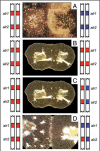Allorecognition and chimerism in an invertebrate model organism
- PMID: 19337403
- PMCID: PMC2634328
- DOI: 10.4161/org.4.4.7151
Allorecognition and chimerism in an invertebrate model organism
Abstract
The presence of highly specific histocompatibility reactions in colonial marine invertebrates that lack adaptive immune systems (such as the sponges, cnidarians, bryozoans and ascidians) provides a unique opportunity to investigate the evolutionary roots of allorecognition and to explore whether homologous innate recognition systems exist in vertebrates. Conspecific interactions among adult animals in these groups are regulated by highly specific allorecognition systems that restrict somatic fusion to self or close kin. In Hydractinia (Cnidaria:Hydrozoa), fusion/rejection responses are controlled by two linked genetic loci. Alleles at each locus are co-dominantly inherited. Colonies fuse if they share at least one haplotype, reject if they share no haplotypes, and display transitory fusion if they share only one allele in a haplotype-a pattern that echoes natural killer cell responses in mice and humans. Allorecognition in Hydractinia and other marine invertebrates serves as a safeguard against stem cell or germline parasitism thus, limiting chimerism to closely related individuals. These animals fail to become tolerant even if exposed during early development to cells from a histoincompatible individual. Detailed analysis of the structure and function of molecules responsible for allorecognition in basal marine invertebrates could provide clues to the innate mechanisms by which higher animals respond to organ and cell allografts, including embryonic tissues.
Keywords: allorecognition; chimerism; innate immune system; invertebrate.
Figures




Similar articles
-
Allorecognition proteins in an invertebrate exhibit homophilic interactions.Curr Biol. 2015 Nov 2;25(21):2845-2850. doi: 10.1016/j.cub.2015.09.030. Epub 2015 Oct 8. Curr Biol. 2015. PMID: 26455308 Free PMC article.
-
Embryonic chimerism does not induce tolerance in an invertebrate model organism.Proc Natl Acad Sci U S A. 2007 Mar 13;104(11):4559-64. doi: 10.1073/pnas.0608696104. Epub 2007 Mar 5. Proc Natl Acad Sci U S A. 2007. PMID: 17360563 Free PMC article.
-
A hypervariable invertebrate allodeterminant.Curr Biol. 2009 Apr 14;19(7):583-9. doi: 10.1016/j.cub.2009.02.040. Epub 2009 Mar 19. Curr Biol. 2009. PMID: 19303297 Free PMC article.
-
Model systems of invertebrate allorecognition.Curr Biol. 2011 Jan 25;21(2):R82-92. doi: 10.1016/j.cub.2010.11.061. Curr Biol. 2011. PMID: 21256442 Review.
-
The Hydractinia allorecognition system.Immunogenetics. 2022 Feb;74(1):27-34. doi: 10.1007/s00251-021-01233-6. Epub 2021 Nov 13. Immunogenetics. 2022. PMID: 34773127 Review.
Cited by
-
Investigating the potential roles of intra-colonial genetic variability in Pocillopora corals using genomics.Sci Rep. 2024 Mar 18;14(1):6437. doi: 10.1038/s41598-024-57136-5. Sci Rep. 2024. PMID: 38499737 Free PMC article.
-
Cryptic surface-associated multicellularity emerges through cell adhesion and its regulation.PLoS Biol. 2021 May 13;19(5):e3001250. doi: 10.1371/journal.pbio.3001250. eCollection 2021 May. PLoS Biol. 2021. PMID: 33983920 Free PMC article.
-
Immunoglobulin-like receptors and the generation of innate immune memory.Immunogenetics. 2022 Feb;74(1):179-195. doi: 10.1007/s00251-021-01240-7. Epub 2022 Jan 16. Immunogenetics. 2022. PMID: 35034136 Free PMC article. Review.
-
Programmed Cell Death in Neurospora crassa Is Controlled by the Allorecognition Determinant rcd-1.Genetics. 2019 Dec;213(4):1387-1400. doi: 10.1534/genetics.119.302617. Epub 2019 Oct 21. Genetics. 2019. PMID: 31636083 Free PMC article.
-
A Paradigm Shift on the Question of B Cells in Transplantation? Recent Insights on Regulating the Alloresponse.Front Immunol. 2017 Feb 2;8:80. doi: 10.3389/fimmu.2017.00080. eCollection 2017. Front Immunol. 2017. PMID: 28210263 Free PMC article. Review.
References
-
- Sykes M, Auchincloss H, Sachs D. Transplantation Immunology. In: Paul W, editor. Fundamental Immunology. Philadelphia: Lippincott Williams & Wilkins; 2003. pp. 1481–1556.
-
- Welniak L, Blazar B, Murphy W. Immunobiology of allogeneic hematopoietic stem cell transplantation. Annu Rev Immunol. 2007;25:139–170. - PubMed
Grants and funding
LinkOut - more resources
Full Text Sources
